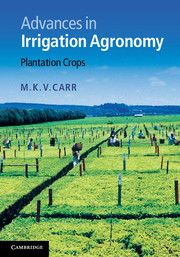6 - Oil palm
Published online by Cambridge University Press: 05 May 2012
Summary
Introduction
The centre of origin of the oil palm (Elaeis guineensis Jacq.) is the tropical rainforest of West Africa where its natural habitat is believed to be in swamps and along river banks. The main economic product is palm oil obtained from the mesocarp in the fruit. Palm kernel oil, which has a different fatty acid composition, is produced in smaller quantities. Kernel cake, produced after the kernel oil has been extracted, is used in animal feeds. Oil palm is the highest yielding oil crop (t ha−1) in the world. Traditionally, palm oil was used in soap, margarine and cooking fat, but is now largely used in food products. It has also become the source of more diverse materials (Corley and Tinker, 2003). When grown as a smallholder crop, the oil palm contributes much more than oil to the communities living in the areas where it is cultivated. For, example, the sap can provide raw material for sugar and alcoholic beverages. The palms are also a source of building materials, and some of the tissues are important sources of fibre.
The oil palm has long been important to village economies throughout its area of distribution in the forests of West Africa, where semi-wild palm groves became established around homesteads (Nouy et al., 1999). The export of palm oil and kernels from Africa grew rapidly in the late nineteenth century, while the first large-scale plantations in Malaysia and Indonesia were established in the early years of the twentieth century. These were followed in the 1920s by plantations in the Congo and later in other parts of West Africa (Corley, 1976a). It is now grown between latitudes 19° N (Dominican Republic) and 15° S (Brazil). In 2009, the two largest palm oil producers by far were Indonesia (85 million t fresh fruit bunches from 5 million ha) and Malaysia (83 million t from 3.9 million ha). This represents a substantial proportion of the estimated total global area of 14.7 million ha. In terms of fruit production these two countries produce 81% of the world total with fruit bunch yields averaging 17–21 t ha−1 (containing 3.4–4.2 t ha−1 of mesocarp oil) (FAO, 2011a).
- Type
- Chapter
- Information
- Advances in Irrigation AgronomyPlantation Crops, pp. 145 - 168Publisher: Cambridge University PressPrint publication year: 2012

